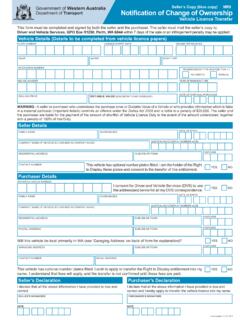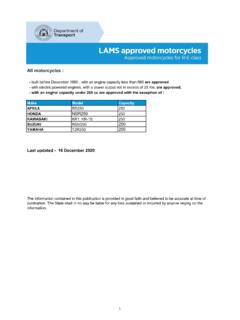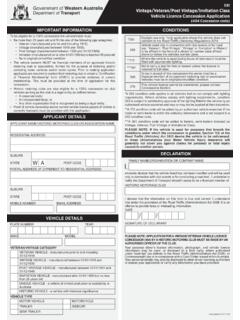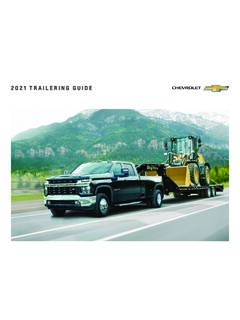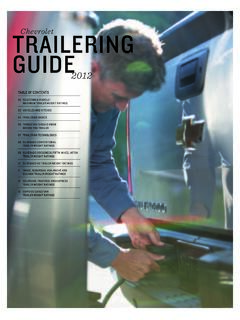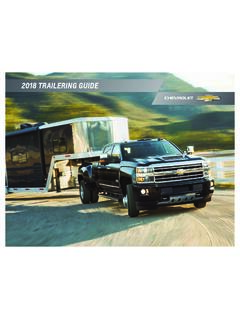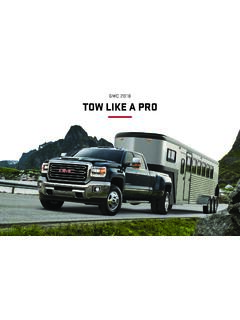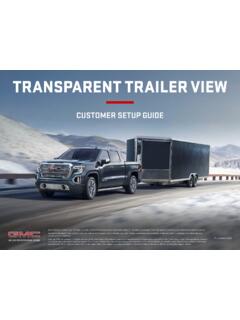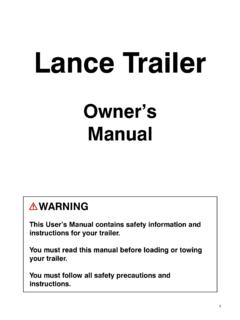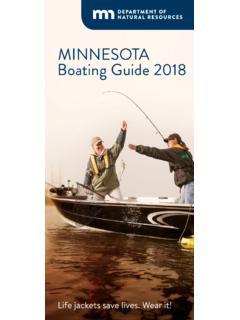Transcription of IB - 107 - Safe Towing
1 IB-107B Vehicle Safety and Standards Information Bulletin Safe Towing Everything you need to know for safe Towing There have been many changes in vehicle design over recent y ears. Modern v ehicles are not necessarily stronger than old vehicles in regard to Towing . Owners need to understand their v ehicle Towing capabilities to prevent costly damage and accidents. Owners also need to know how to equip your vehicle and how to fit and l oad what they intend to tow. This brochure deals with these issues as well as the amendments to traffic regulati ons and vehicle standards that took effect on 1 November 2002, one issue being changes to some vehicles' Towing limits. See the section, "How much can you safely tow? Some laws that you need to know Vehicles, trailers and caravans must meet registration standards and must be roadworthy.
2 All traile rs or caravans must have a rear number plate and a registration label holder fixed to the left side of the body so that the label faces outwards or forwards. The coupling and towbar must not obscure the number plate or lights on the rear of the Towing vehicle when no trailer or caravan is attached. Regulations prohibit Towing more t han one trailer at once. Nobody is allowed to ride in normally registered trailers or caravans. When Towing a trailer or caravan the maximum speed at which you may tow is 100 kilometres per hour. You must of course obey the posted speed limits. Following distances outside built-up areas - On roads outside a built-up area that do not have more t han one lane in the direction you are driving, there are specific minimum following distances for long vehicles.
3 If your vehicle is long or longer (including any trailer and load) you may not follow closer than 200m to a similar vehicle in fr ont of you. The exception is when you are overtaking. St opping on carriageways - If your vehicle including trailers and load is longer than or has a total mass of more t han tonnes you may not: Stop on a carriageway in a built-up area for longer than one hour unless engaged in picking up or setting down goods; or IB-107 (May 2015) Page 1 of 9 Stop on a carriageway outside a built-up area except on a shoulder or in a truck bay or other area set aside for parking of goods vehicles. Do not overtake turning vehicle signs Changes to the traffic regulations have given increased right of way upon turning for long vehicles displaying the sign "Do not overtake turning vehicle".
4 If your vehicle (meaning the Towing vehicle together with the trailer and projecting load) is long or longer you may have the sign "Do not overtake turning vehicle" displayed at the rear. This can be either a separate sign or the words can be incorporated on one of a pair of rear marking plates. Rear marking plates may be fitted to traile rs and caravans. The Department of Transport s (DoT) brochure on 'Rear Marking Plates' provides detailed information on their fitment. If this sign is attached to the rear of your vehicle, other vehicles must give way whilst your vehicle uses part or all of an adjacent second l ane for turning. You will have right of way to complete such turns. It is an offence not to display this sign on a vehicle (meaning the Towing vehicle together with the trailer and projecting load) with a combined length of more t han long if lanes need to be straddled when turning.
5 It is an offence to display this sign on a vehicle (meaning the Towing vehicle together with the trailer and projecting load) with a combined length less than long, however, it is not ill egal to use normal rear marking plates without "Do not overtake turning vehicle" on such a vehicle. How to equip your vehicle for Towing Your vehicle must be suitable and properly equipped for the type of trailer to be towed, with towbars and couplings properly designed and fitte d. Electrical sockets for trailer lights, must be fitted to the Towing vehicle, and where necessary suitable brake connections. If you are Towing a wide traile r or caravan extra mirrors may be required on your vehicle. (These should be removed when not Towing ). Vehicles with automatic transmission may require extra tr ansmission oil cooling.
6 To tow heavy loads some vehicles may need strengthening, and/or special transmission and suspension options. A load distributing device may also be required. You should check the vehicle handbook or consult the manufacturer or the vehicle distributor regarding these requirements. How much can you safely tow? Most manufacturers specify Towing limits for their vehicles in their handbooks. For vehicles of Gross Vehicle Mass tonnes or less the following limits are applicable: Towing limits specified by the vehicle manufacturer must no t be exceeded, otherwise safety will be compromised. Excessive loads may also damage your vehicle. IB-107 (May 2015) Page 2 of 9 If the vehicle's Towing capacity cannot be determined, the loaded mass of the trailer must not exceed the empty mass (tare) of the Towing vehicle, excepting where the trailer is fi tted with brakes in which case the loaded mass of the trailer must not exceed times the empty mass of the Towing vehicle.
7 If the trailer is not fi tted with brakes then the loaded mass of the trailer must not exceed 750kg. The loaded mass o f the trailer must not exceed the Towing capacity of any component in the vehicle/ trailer combination, including the towbar and towball. The loaded mass o f the trailer must never exceed the trailer 's ATM. Towbar saf ety requirements Your towbar must comply with Australian Design Rules, Standards and Regulations. The capacity of your towbar and coupling must be at least equal to the loaded mass of the trailer . A towbar fitted to a vehicle built after January 1992 must be marked with its load capacity and either the vehicle model for which it is designed or the towbar manufacturer's part number. The towbar must not protrude dangerously, or have sharp corners that could be a safety hazard w hen no traile r is fitted to your vehicle.
8 Towbar chain attachments must be able to withstand the rated load capacity of the towbar. The safety chain attachments must be mounted adjacent to the tow coupling and arranged so as to maintain the direction of the trailer in the event of coupling failure or disconnection. In the event of coupling failu re or disc onnection, the safety chain(s) should support the drawbar and prevent it dropping to the ground. IB-107 (May 2015) Page 3 of 9 Towbars with a removable Towing lug should be fitted with safety chain connections on the non-removable part of the towbar. If the chain connections are on the removable l ug then the lug must be restrained by an additi onal c hain to prevent disconnection from the towbar if the lug attachment fails. trailer safety requirements Your trailer must meet all the standards required for registration.
9 New trailers must comply with the Australian Design Rules as summarised for small trailers in the Vehicle St andards Bulletin No. 1 issued by the Department of Infrastructure and Regional Development. The coupling must be properly designed in accordance with the appr opriate Australian St andard for couplings to match the full trailer load capacity and it must be marked with the load capacity and the manufacturer's name or trade mark. "Quick Release Couplings" which can be engaged or disengaged without the use of tools must be used when the trailer 's ATM is less than 3500 kg. Typical approved couplings include 50mm Ball couplings for trailers with ATM up to 2300kg (standard duty ball) and up to 3500kg (heavy duty ball), and Pintle Hook couplings for traile rs with ATM up to 4500kg. Trailers of ATM up to and including 2500kg must be fitted with at least one safety chain for connection to the Towing vehicle.
10 Trailers of ATM over 2500kg must be fitted with two safety chains. Trailers having only a single axle and a GTM not exceeding 750kg do not require brakes. Trailers of GTM over 750kg must have brakes. Traile rs of GTM over 750kg and not exceeding 2000kg must have braking on the wheels of at least one axle. Trailers of GTM over 2000kg must have braking on all wheels. Over-ride brakes may be used on traile rs of GTM up to and including 2000kg. Trailers of GTM over 2000kg must have brakes operated from the driver s seated position. Over-ride brakes are not permitted. These trailers m ust have a breakaway system by which the brakes are automatically applied if the traile r becomes detached from the Towing vehicle. Electrical lighting , wiring and reflectors must be manufactured and installed in accordance with Australian Design Rules.

